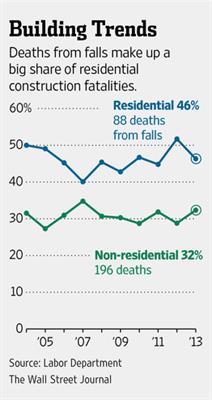According to OSHA, an estimated 1.6 million Americans work in the construction industry, half of which work in residential construction. Each year, roughly 38,000 construction injuries are reported, with some 21,000 involving days away from work. Numerous OSHA standards apply to residential construction for the prevention of possible injuries and fatalities and many of the injuries in residential construction could have easily been prevented if OSHA regulations were followed.
Generally speaking, when residential construction experiences growth, it contributes to higher injury  rates and fatalities in construction. For example, according to the U.S. Bureau of Labor Statistics, the total case incident rate (TCIR) for the state of Michigan construction increased from 2.6 injuries and illnesses per 100 full-time workers in 2011 to 5.0 in 2012. From 2008 to 2013, over 37% of construction fatalities in Michigan have occurred in the residential industry.
rates and fatalities in construction. For example, according to the U.S. Bureau of Labor Statistics, the total case incident rate (TCIR) for the state of Michigan construction increased from 2.6 injuries and illnesses per 100 full-time workers in 2011 to 5.0 in 2012. From 2008 to 2013, over 37% of construction fatalities in Michigan have occurred in the residential industry.
OSHA’s interpretation of "residential construction" combines two elements: The end-use of the structure being built must be as a home, i.e., a dwelling; and the structure being built must be constructed using traditional wood frame construction materials and methods.
Also, keep in mind that the limited use of structural steel in a predominantly wood-framed home, such as a steel I-beam to help support wood framing, does not disqualify a structure from being considered residential construction.
Below are the top 5 OSHA violations in residential construction:
- Fall Protection & Fall Protection Training (29 CFR 1926.501 & 1926.503)
- Employees not properly protected at a height of 6 feet or more above a lower level
- Lack of adequate training to employees who might be exposed to fall hazards
- Scaffolding (29 CFR 1926.451)
- Poor planking or supports
- Slips & struck by falling objects
- Ladders (29 CFR 1926.1053)
- Ladders not extended at least 3 feet above upper landing level or secured at top and used with a grab rail
- Improper ladder angle for non-self-supporting ladders (4 to 1 rule)
- Stairways (29 CFR 1926.1052)
- Improperly constructed temporary stairways (proper dimensions, free of hazardous projections, and handrails)
- Head Protection (29 CFR 1926.100)
- Employees working in areas where potential head injury exists, employees not protected
- Head protection does not meet the American National Standards Institute (ANSI) requirements
In March of 2013, OSHA changed the rules for residential construction workers. No longer will they be issuing reduced fines, helpful hints, and consultations on compliance with the fall protection regulations. They are in full-enforcement mode, and you should be in full-compliance mode if you want to avoid serious penalties.
On the bright side, OSHA has developed materials to assist the residential construction industry, including a wide variety of education and training materials to assist employers with compliance. The web pages contain information on applicable OSHA standards, hazards and solutions, safety and health programs, and Spanish language resources. The web pages can found at:
- https://www.osha.gov/SLTC/residential/ (Safety & Health Topics: Residential Construction Industry), and
- http://www.osha.gov/doc/topics/residentialprotection/index.html (Fall Protection in Residential Construction).
Information abstracted in part from the US Department of Labor’s
Bureau of Labor Statistics, Wall Street Journal and OSHA websites.
Related Topics: Safety Awareness, Construction Safety, Monthly Safety Topics, Safety Articles